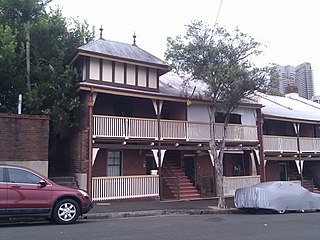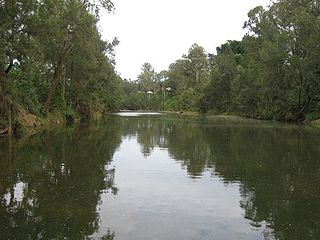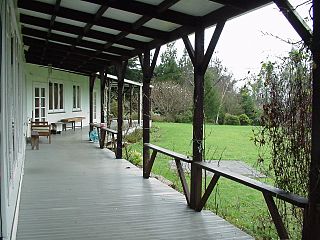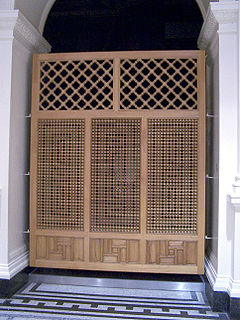
Australian residential architectural styles have evolved significantly over time, from the early days of structures made from relatively cheap and imported corrugated iron to more sophisticated styles borrowed from other countries, such as the Victorian style from the United Kingdom, the Georgian style from North America and Europe and the Californian bungalow from the United States. A common feature of the Australian home is the use of fencing in front gardens, also common in both the UK and the USA.

Queensland Country Women's Association Girls' Hostel is a heritage-listed detached house at 5 Brisbane Street, Ipswich, City of Ipswich, Queensland, Australia. It was built from c. 1885 to c. 1911. It was added to the Queensland Heritage Register on 21 October 1992.

Glenalvon House is a heritage-listed homestead located at 8 Lithgow Street, Campbelltown in the City of Campbelltown local government area of New South Wales, Australia. It was designed and built in 1841 by Michael Byrne. It is also known as Glenalvon and Glenalvon and Stables. The property is owned by Department of Planning and Infrastructure, an agency of the Government of New South Wales. It was added to the New South Wales State Heritage Register on 2 April 1999.

Arcola is a heritage-listed former residence and now bed and breakfast at 150 Victoria Street, Grafton, Clarence Valley Council, New South Wales, Australia. It was built in 1907. It was added to the New South Wales State Heritage Register on 2 April 1999.

Gundayne House is a heritage-listed residence at The Bucketts Way, Booral, Mid-Coast Council, New South Wales, Australia. It was built by stonemason Sam Carnell. It was added to the New South Wales State Heritage Register on 2 April 1999.

Alloway is a heritage-listed cottage located at 15 Gwydir Street, Moree, in the Moree Plains Shire local government area of New South Wales, Australia. It was built during 1875. The cottage was added to the New South Wales State Heritage Register on 2 April 1999.

Tulloona is a heritage-listed residence at 562 Ballina Road, Goonellabah, City of Lismore, New South Wales, Australia. It was built from 1895 to 1896. It has also been known as Northcott House and St Peter's Anglican Church. It was added to the New South Wales State Heritage Register on 2 April 1999.

Hestock is a heritage-listed residence located at 14 Crescent Street, Hunters Hill in the Municipality of Hunter's Hill local government area in New South Wales, Australia. It was designed by Walter Liberty Vernon and built during 1885. It is also known as Le Chalet. It was added to the New South Wales State Heritage Register on 2 April 1999.

Perth House is a heritage-listed former residence and school for girls at 85 George Street, Parramatta, Sydney, New South Wales, Australia. It was designed by James Houison and built in 1841. It was added to the New South Wales State Heritage Register on 2 April 1999.

Tarella is a heritage-listed former residence and now business premises located at 3 Amherst Street, Cammeray, North Sydney Council, New South Wales, Australia. It was built from 1874 to 1886. The property is privately owned. It was added to the New South Wales State Heritage Register on 2 April 1999.

Belvedere is a heritage-listed residence at 7 Cranbrook Avenue, Cremorne, North Sydney Council, New South Wales, Australia. It was designed by Alexander Stewart Jolly. It was added to the New South Wales State Heritage Register on 2 April 1999.

Wyoming is a heritage-listed residence at 25 Wharf Road, Birchgrove, Inner West Council, New South Wales, Australia. It was added to the New South Wales State Heritage Register on 2 April 1999 and the former Register of the National Estate on 28 May 1996.

Lilyvale is a heritage-listed former town house and now restaurant located at 176 Cumberland Street, in the inner city Sydney suburb of The Rocks in the City of Sydney local government area of New South Wales, Australia. It was built from 1845 to 1847. The property is owned by Property NSW, an agency of the Government of New South Wales. It was added to the New South Wales State Heritage Register on 10 May 2002.

65 Windmill Street, Millers Point is a heritage-listed boarding house and former residence located at 65 Windmill Street, in the inner city Sydney suburb of Millers Point in the City of Sydney local government area of New South Wales, Australia. The property was added to the New South Wales State Heritage Register on 2 April 1999.

62-64 Argyle Place, Millers Point is a heritage-listed row of two terrace houses located at 62-64 Argyle Place, in the inner city Sydney suburb of Millers Point in the City of Sydney local government area of New South Wales, Australia. The property was added to the New South Wales State Heritage Register on 2 April 1999.

Linsley Terrace is a series of heritage-listed terrace houses located at 25-35 Lower Fort Street, in the inner city Sydney suburb of Millers Point in the City of Sydney local government area of New South Wales, Australia. It was built from 1830. It is also known as Major House. The property was added to the New South Wales State Heritage Register on 2 April 1999.

15-25 Dalgety Road, Millers Point are heritage-listed terrace houses located at 15-25 Dalgety Terrace, in the inner city Sydney suburb of Millers Point in the City of Sydney local government area of New South Wales, Australia. The property is also called Dalgety Terraces and Dalgety Terrace. The property was added to the New South Wales State Heritage Register on 2 April 1999.

2-36 High Street, Millers Point are heritage-listed terrace houses located at 2-36 High Street, in the inner city Sydney suburb of Millers Point in the City of Sydney local government area of New South Wales, Australia. The property was added to the New South Wales State Heritage Register on 2 April 1999.

46 Kent Street, Millers Point is a heritage-listed terrace house located at 46 Kent Street, in the inner city Sydney suburb of Millers Point in the City of Sydney local government area of New South Wales, Australia. It was added to the New South Wales State Heritage Register on 2 April 1999.




























